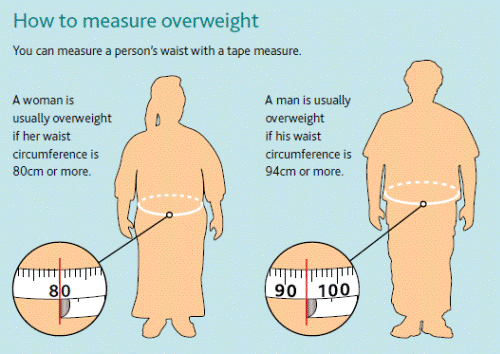Attitudes to being overweight
In South Africa, women’s responses to ‘being large’ included: ‘If you are large, you have a presence and can be easily seen’ … ‘People know you are healthy (i.e. are not HIV positive)’… ‘Husbands prefer fat women’. Attitudes were overwhelmingly positive towards overweight and the risks were not recognised. Yet the con-sequences of being overweight can be life threatening. Being overweight increases the risk of heart disease (including stroke), diabetes, osteoarthritis (a disease of the joints) and some cancers (uterus, breast and co-lon).
Clearly we need to change attitudes about being overweight and increase awareness about these serious risks. However we should be sensitive when communicating with individuals about their weight.
What is healthy eating?
It is a diet that maintains a healthy weight in adults, enables healthy growth in children, has a variety of foods and provides enough energy and nutrients.
Tips for healthy eating
- Eat a variety of foods at each meal
- Eat wholegrain cereals, legumes (e.g. peas, beans, lentils) and nuts
- Eat plenty of fruits and vegetables
- Limit the amount of fats, oils and fatty foods
- Limit the amount of sugar and sugary foods
- Eat less salt.
Why eat a variety of foods?
This helps ensure that all essential nutrients will be present. For example, staple cereals like wheat and rice contain no vitamin A, vitamin C or vitamin B12 so these need to be provided from other foods. These vita-mins help to give you good vision, normal growth and development. They are also important in fighting in-fections, healing wounds and making blood cells.
Why eat wholegrain cereals, legumes and nuts?
- To provide soluble fibre which helps lower cholesterol and reduces the risk of heart attack and stroke
- To provide insoluble fibre to keep the gut healthy and reduce the risk of bowel cancer.
Choose brown bread, brown rice, oatmeal or rolled oats, bulgur wheat or quinoa.
Why eat plenty of fruits and vegetables?
- To provide minerals and vitamins that may be lacking in the main diet
- To provide anti-oxidant nutrients which reduce the risk of cancer
- To provide soluble and insoluble fibre.
Aim to have five portions of fruit and vegetables a day. Potatoes, yam, cassava and plantain do not count as a portion.
Why limit fats, oils and fatty foods?
- To reduce the risk of becoming overweight. These foods are concentrated sources of energy and make it more difficult to maintain a healthy weight.
- To reduce the risk of heart attacks and stroke. Saturated fats increase ‘bad’ cholesterol in the blood and increase the risk of heart disease. They are found in dairy foods (butter, cheese, cream, whole milk), fatty meat, lard, ghee, hard margarine, coconut and red palm oil. Some foods (biscuits, cakes, pastries) con-tain hidden saturated fats.
For cooking, choose soya, groundnut, sunflower, olive, rapeseed, safflower, corn, or blended vegetable oils.
Why limit sugar and sugary foods?
- To reduce the risk of becoming overweight. These foods are concentrated sources of energy. Sodas and bottled drinks contain lots of hidden sugar.
Why eat less salt?
- To reduce the risk of high blood pressure, which increases the risk of heart disease and stroke.
Some foods contain hidden salt, including cheese, processed meat, packet and canned soups, stock cubes (for soups etc), processed snacks and ready-to-eat meals. Try not to add salt at the table. However your body does need some salt to work well, particularly in very hot climates where you lose salt through sweating. You may become dizzy or faint if you do not have enough salt in your diet.
Dr Ann Ashworth is Emeritus Professor of Community Nutrition at the London School of Hygiene and Tropical Medicine.
Email: [email protected]
Health in pregnancy: avoiding low birth weight
Low birth weight increases the risk of death during infancy. It also increases the risk of high blood pressure, heart disease and diabetes in adult life. To avoid low birth weight, pregnant women should eat healthily and:
- avoid long gaps between meals (snacking is good)
- not take part in religious fasts
- not smoke or chew tobacco
- avoid alcohol.
Malaria in pregnancy also decreases birth weight. In endemic areas advise pregnant women to sleep under an insecticide-treated net and receive IPT (intermittent preventive treatment) at the antenatal clinic.
Discussion questions
- What staple foods do we eat in this area? (A staple food is the main food eaten. Examples are rice, maize, cassava, yam, plantain.)
- Which other foods do we usually eat with the staple food? Now check if these foods include pulses, nuts, vegetables, fruit, meat, fish. If not, consider why not.
- How many types of fruit and vegetables (including green leaves) are available in our area? How could a person achieve five portions a day?
- How many portions a day of fruit and vegetables do we currently eat in our area? Discuss ways to encourage families to eat five portions a day.
- How much is lack of money a barrier to a healthy diet?
- Discuss ways in which families could improve the variety of foods eaten at little or no cost.
- Are there times of the year when fruits and vegetables are not available? What can families do to overcome seasonal shortages?
- Are wild plants eaten traditionally as a source of fruit or green leaves in our area? Should eating these be encouraged?
The PILLARS guide on Healthy Eating contains more discussion questions like these.









